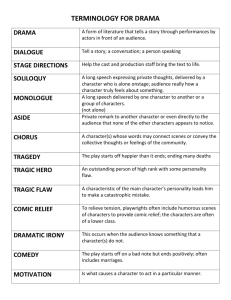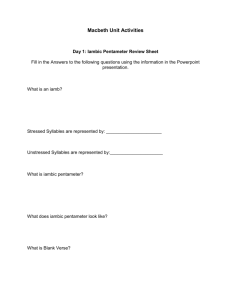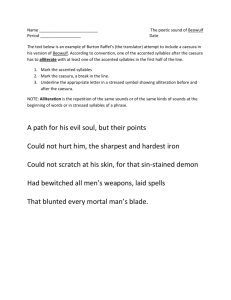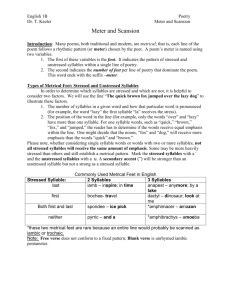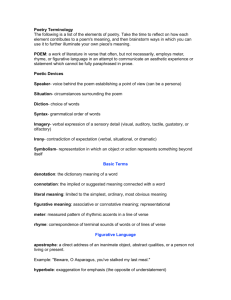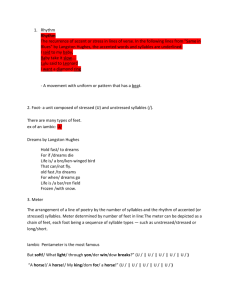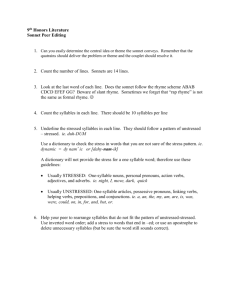Literary terms to discuss prose and verse • Sound • Verse
advertisement
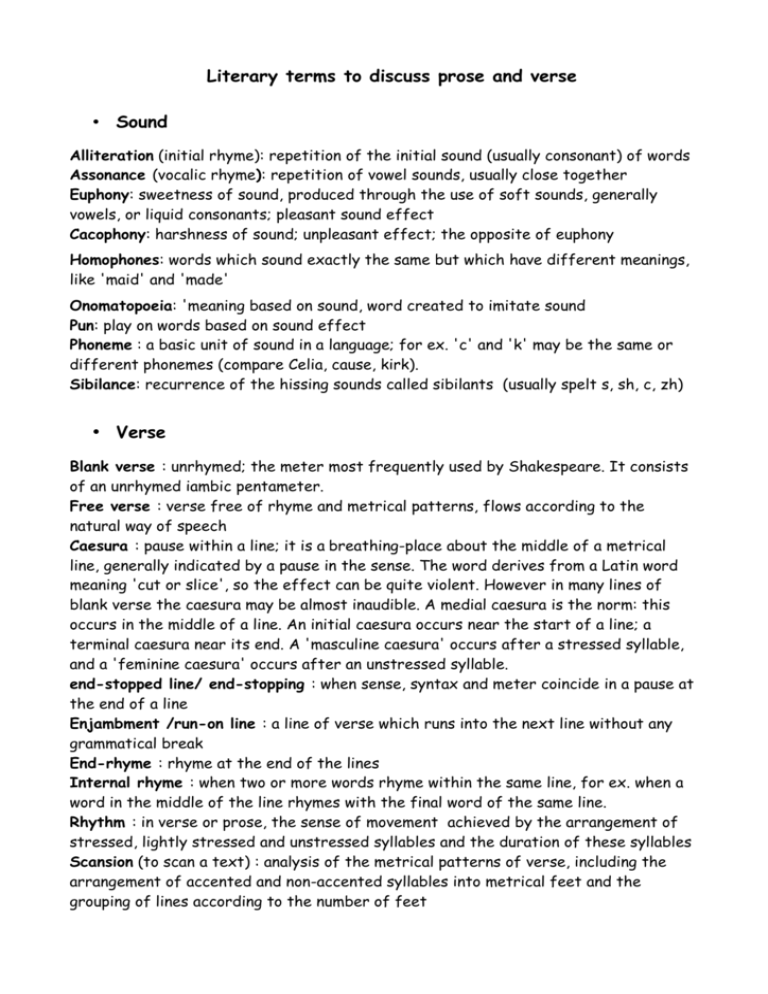
Literary terms to discuss prose and verse
• Sound
Alliteration (initial rhyme): repetition of the initial sound (usually consonant) of words
Assonance (vocalic rhyme): repetition of vowel sounds, usually close together
Euphony: sweetness of sound, produced through the use of soft sounds, generally
vowels, or liquid consonants; pleasant sound effect
Cacophony: harshness of sound; unpleasant effect; the opposite of euphony
Homophones: words which sound exactly the same but which have different meanings,
like 'maid' and 'made'
Onomatopoeia: 'meaning based on sound, word created to imitate sound
Pun: play on words based on sound effect
Phoneme : a basic unit of sound in a language; for ex. 'c' and 'k' may be the same or
different phonemes (compare Celia, cause, kirk).
Sibilance: recurrence of the hissing sounds called sibilants (usually spelt s, sh, c, zh)
• Verse
Blank verse : unrhymed; the meter most frequently used by Shakespeare. It consists
of an unrhymed iambic pentameter.
Free verse : verse free of rhyme and metrical patterns, flows according to the
natural way of speech
Caesura : pause within a line; it is a breathing-place about the middle of a metrical
line, generally indicated by a pause in the sense. The word derives from a Latin word
meaning 'cut or slice', so the effect can be quite violent. However in many lines of
blank verse the caesura may be almost inaudible. A medial caesura is the norm: this
occurs in the middle of a line. An initial caesura occurs near the start of a line; a
terminal caesura near its end. A 'masculine caesura' occurs after a stressed syllable,
and a 'feminine caesura' occurs after an unstressed syllable.
end-stopped line/ end-stopping : when sense, syntax and meter coincide in a pause at
the end of a line
Enjambment /run-on line : a line of verse which runs into the next line without any
grammatical break
End-rhyme : rhyme at the end of the lines
Internal rhyme : when two or more words rhyme within the same line, for ex. when a
word in the middle of the line rhymes with the final word of the same line.
Rhythm : in verse or prose, the sense of movement achieved by the arrangement of
stressed, lightly stressed and unstressed syllables and the duration of these syllables
Scansion (to scan a text) : analysis of the metrical patterns of verse, including the
arrangement of accented and non-accented syllables into metrical feet and the
grouping of lines according to the number of feet
Stanza : a group of lines of verse, whose pattern is determined by the number of
lines, the number of syllables in each line, the rhyming and metrical schemes. It is the
unit of structure in a poem, and is usually left unbroken, unless the poet is looking to
achieve specific effects.
Combinations of lines of verse
Alexandrine: a line of 6 iambic feet, traditionally used to mark a conclusion in a work
written in heroic couplets. This term is also used in French poetry to mean a line of
twelve syllables.
Ballad : a song that tells an epic story from an external pov, mainly through dialogue
and action, using simple vocabulary and little or no detail of surroundings or feelings.
Its opening can be abrupt as its form is terse, and it focuses on a single line of action.
Its theme is often tragic, imagery is sparse, and it usually contains a refrain.
The folk or traditional ballad is anonymous and transmitted by word of mouth,
whereas the literary ballad bears a poet's signature and more elaborate style.
Couplet: a rhymed pair of lines, which are usually of the same length. If these are
iambic pentameters, it is termed a heroic couplet. This form was made popular by
Chaucer's Canterbury Tales and became the dominant poetic form in the latter part of
the seventeenth century. Couplets of four iambic feet (i.e. eight syllables in all) are
called octosyllabic couplets.
Lai or lay : a short narrative poem written in octosyllabic couplets; term of French
medieval origin, anglicized as Breton lay.
Tercet or triplet : a group of three lines as a single stanza, or as part of a pair
forming a sestet
Quatrain : a stanza of four lines; the most common form in English poetry
Sestet : a stanza of six lines
Heptastich : a stanza of seven lines
Octave or octet : a group of eight lines, either in stanza form, as in ottava rima, or as
the first eight lines of a sonnet, in which case it usually rhymes abbaabba
Rime Royal : a seven-line iambic pentameter stanza rhyming ababbcc
Sonnet : a lyric poem of fourteen iambic pentameter lines. There are several types of
sonnet, each following a specific and intricate rhyming pattern. The most frequent
types in English are as follows: The Italian or Petrarchan sonnet is composed of one
octave and a sestet, rhyming abbaabba + cdecde (or variant); its subject matter is
usually the hopes and pains of a male lover/admirer. The English or Shakespearean
sonnet is composed of three quatrains and a final couplet, rhyming abab cdcd efef gg;
its variant, the Spenserian sonnet, rhymes abab bcbc cdcd ee, thereby linking each
quatrain to the next.
Terza Rima : composed of tercets interlinked by a common rhyme, aba bcb cdc, etc.
Ottava Rima : an eight-line poem, rhyming abababcc.
Spenserian stanza : a nine-line stanza composed of eight iambic pentameter and one
iambic hexameter (Alexandrine), rhyming ababcbcc.
Villanelle : a poem composed of a variable number of tercets (usually five) and a final
quatrain, rhyming aba (x5) abaa. The first and third lines of the opening tercet are
repeated alternately as the third lines of the following tercets.
Metrical patterns
Foot : the basic unit for describing meter, usually consisting of a certain number and
combination of stressed and unstressed syllables. Stressed and unstressed syllables
form one or other of the recognised metrical forms
Iamb (iambic): a metrical foot consisting of two syllables, in which the first is
unstressed and the last is stressed: 'di dum' ◎◉
Trochee (trochaic) : a metrical foot consisting of two syllables, in which the first is
stressed and the last is unstressed: 'dum di ' ◉◎
Spondee (spondaic) : a metrical foot consisting of two syllables, in which both are
stressed; dum dum ◉◉
Phyrrhic (phyrrhic) : a metrical foot consisting of two syllables, in which neither is
stressed; di di ◎◎
Anapaest : a metrical foot consisting of three syllables, in which the first two are
unstressed and the last is stressed; 'di di dum' ◎◎◉
Dactyl: A metrical foot consisting of three syllables, in which the first is stressed and
the last two are unstressed; 'dum di di' ◉◎◎
Monometer : 1 foot; dimeter : 2 feet; trimeter : 3 feet; tetrameter : 4 feet;
pentameter : 5 feet; hexameter* : 6 feet; heptameter* : 7 feet; octameter : 8 feet
*Alexandrine: a line of 6 iambic feet
*Fouteener: a line of seven iambic feet (usually 4 + 3 )
• The sentence
Hypotaxis (hypotactic) : the elements that form a sentence, or a sequence of
complete sentences within a paragraph, are linked by connectives such as 'when, so,
therefore', or by subordinate clauses
Parataxis (paratactic) : the elements that compose the sentence are juxtaposed and
at most connected by 'and'
Periodic sentence : the full sense of the sentence remains suspended until the closure
of the syntax. Highly composed syntactic structure
Non-periodic sentence : so loosely composed that meaning would remain intact if a
full-stop was inserted at one or more places before the actual close
• Narrative techniques and devices, layers of meaning
Denotation : literal meaning of a word
Connotation : associated meaning
Polysemy : several meanings in one word or sequence
Foregrounding:drawing attention to the form of language itself through the use of
devices and techniques that push the act of expression into the foreground
Voice/ narrator/persona : Aristotle and Plato distinguish 3 types of narrator; the
speaker or poet who uses their own voice, the narrator who adopts a persona or
someone else's voice, and the one who uses both. The term persona stands for 'mask
of the author'.
Heteroglossia (heteroglossic) : the coexistence of conflicting voices
Analepsis, retrospective or flashback: an event or narrative that reveals the past
Prolepsis, foreshadowing : an event or narrative that hints at what is to be
Diegesis (N), diegetic (adj) : the story
Extradiegetic narrator : is above or outside the story level
Intradiegetic narrator :at the story level
Homodiegetic narrator : is involved in the story
Heterodiegetic narrator : is not involved in the story
hypodiegetic : when a story is embedded in another story, the level of the story is
hypodiegetic, and so is its narrator
Reliable narrator : one you can trust
Fallible narrator : one who may not tell or know the whole story
Focalisation : the zooming process that allows the reader to see through the eyes of
a character
Shift : a change in focalisation
Authorial irony : when the author lets the reader hear his/her irony above the
character or even above the narrator
Dramatic irony : when the reader knows something the character doesn't
Tragic irony : when that something can lead the character to his/her death or to
great loss
• Plot
Anagnorisis : recognition or discovery by the protagonist of some fundamental
element that leads to the resolution of the plot/denouement
Exposition : essential information about the plot and the events to come given at the
beginning of a play
Initiating action : the events which bring about a state of tension
Fulcrum : pivot or turning point
Rising action or complication : the development of conflicts
Climax : the highest point of tension
Closure : conclusion, end, ending.
Resolution, falling action, dénouement: untying of the complications of the plot
•
Figures of thought and of speech
Rhetorical Figures : linguistic effect can be perceptible to the mind and/or the eye.
Figures of thought appeal to the mind by twisting language in a way that is strictly
improper, but licensed by usage. Thus the word 'is' is used improperly in the sentence
'John is a lion', but the metaphorical usage is permissible. Or when we hear the
sentence 'All hands on deck', we understand that the word 'hands' is being used as a
synecdoche for sailors. Figures of thought are sometimes called trope (from a Greek
word meaning 'turn' or 'twist') or conceits (from a Latin word meaning 'concept',
because the conceit appeals to the mind). Figures of speech are perceptible to the
eye and the ear. Thus rhyme is a figure of speech, as are alliteration and anaphora.
Figurative language uses figures of speech, like metaphors, alliterations, etc, and is
distinct from literal language; eg. 'She flew at him like a bat' is figurative (metaphor
+ simile), whereas 'she went towards him in a fast and threatening way' is literal.
Anaphora: repetition of the same word(s) at the beginning of consecutive syntactic
units
Antithesis : opposition; contrasting ideas sharpened by the use of opposites, for
example 'to be or not to be'
Hendiadys : one through two; association of two substantives to create an interwoven
notion, for example 'darkness and the shadow of death'
Hyperbole : exaggeration to emphasise something ; eg. I could eat a horse↬I am very
hungry
Simile : explicit comparison of two elements, usually connected by 'like', or 'as'; eg. :
She is like a butterfly. (comparison: she is as beautiful and delicate as a butterfly)
Metaphor : substitution; an implicit comparison of two unlike elements (no (like' or
'as'). eg. : She is a butterfly. So, a metaphor is the transfer of a quality or attribute
from one thing or idea to another in such a way as to imply some resemblance between
the two things or ideas: 'his eyes blazed' implies that his eyes become like a fire.
Many metaphors have been absorbed into the structure of ordinary language to such
an extent that they are all but invisible, thus becoming dead metaphors, and it is
sometimes hard to be sure what is or is not dead metaphor: 'the fat book' may imply a
metaphor. Mixed metaphors often occur when a speaker combines two metaphors
from very diverse areas in such a way as to create something which is physically
impossible or absurd ('the report of the select committee was a bombshell which got
right up my nose'). These often result from the tendency of metaphors to become
received idioms (dead metaphors) in which the original force of the implied comparison
is lost.
Metonymy : a metaphor by close association, for ex. “heat” for a stove, 'the crown'
for the monarchy, 'Nb 10 (Downing Street)' for the Prime Minister of UK, 'Elizabeth
Gaskell' for her work ('have you read E. Gaskell?')
Synecdoche : the part stands for the whole: 'A myriad of hats entered the room' for
the people wearing the hats, 'hands' for workers; or the whole stands for the part :
'Manchester' for one of the city's football teams
Oxymoron (-ic) : combination of two contradictory terms in a compressed paradox; for
ex. cruel kindness, living dead, darkness visible, cold sun
Paradox : surprising association of two apparently contradictory terms that can or
cannot be resolved; for ex. 'Everything I say is a lie', 'You have to be cruel to be
kind'. A paradox can also lie in the very foundation of an idea or thesis, in which case
it is a wider and/or more abstract form of it.
Personification : attribution of human qualities to inanimate objects or animals
Prosopopeia : same as above; also to make the dead (or absent) speak
Pathetic fallacy : coined by John Ruskin; a derogatory term for personification; today
used neutrally
Pathos : suffering, feeling; the quality of a work of art which evokes tenderness, pity
or sorrow. For ex., in Hamlet, Gertrude's speech describing Ophelia's death. Note
that bathos is the excess of pathos, elevation, etc, which unintentionally turns the
text into ridiculous exaggeration.
Trope: a generic term for any figure of speech that transforms literal meaning into
figurative meaning, i.e. metaphor, synecdoche, metonymy, simile, allegory, etc.
• For forms of expression, see:
Direct speech
Indirect/ Reported speech
Dialogue
Soliloquy
Monologue
Free indirect style
Stream of consciousness
Further reading
A Glossary of Literary Terms, M.H. Abrams; Holt, Rinehart and Winston, Inc.
Dictionary of Literary Terms & Literary Theory, J.A. Cuddon/C.E. Preston; Penguin Books
Oxford Dictionary of Literary Terms, Chris Baldick; Oxford University Press
How Fiction Works, James Wood, Vintage Books
http://www.english.cam.ac.uk/vclass/terms.htm
